Marketing operations excellence has emerged as the cornerstone of successful B2B organizations, with companies achieving 85% ROI improvements through strategic implementation of integrated processes, technology, and data-driven decision making. As the field experiences 8% annual growth and median salaries reach $161,030, understanding the framework for operational excellence becomes critical for competitive advantage.
The Strategic Imperative of Marketing Operations Excellence
In today’s rapidly evolving business landscape, marketing operations excellence represents far more than efficient campaign execution—it embodies the strategic transformation of how organizations approach customer engagement, revenue generation, and competitive positioning. According to Forrester Research, executing B2B marketing objectives requires optimal performance from people, processes, and technology, with marketing operations leaders serving as the critical bridge between strategic vision and tactical execution [1].
The Bureau of Labor Statistics projects 8% growth in marketing management roles from 2023 to 2033, significantly faster than the average for all occupations, with 31,100 new positions expected to emerge [2]. This growth trajectory reflects the increasing recognition that marketing operations excellence directly correlates with organizational success, as companies struggle to navigate complex customer journeys, fragmented technology ecosystems, and mounting pressure for measurable ROI.
However, achieving marketing operations excellence presents significant challenges. Many organizations operate with fragmented systems, manual processes, and limited cross-functional alignment. Research from the Library of Congress Marketing Industry Resource Guide indicates that while comprehensive industry reports from Duke University’s CMO Survey and trade publications like AdAge document the importance of operational excellence, implementation remains inconsistent across organizations [3].
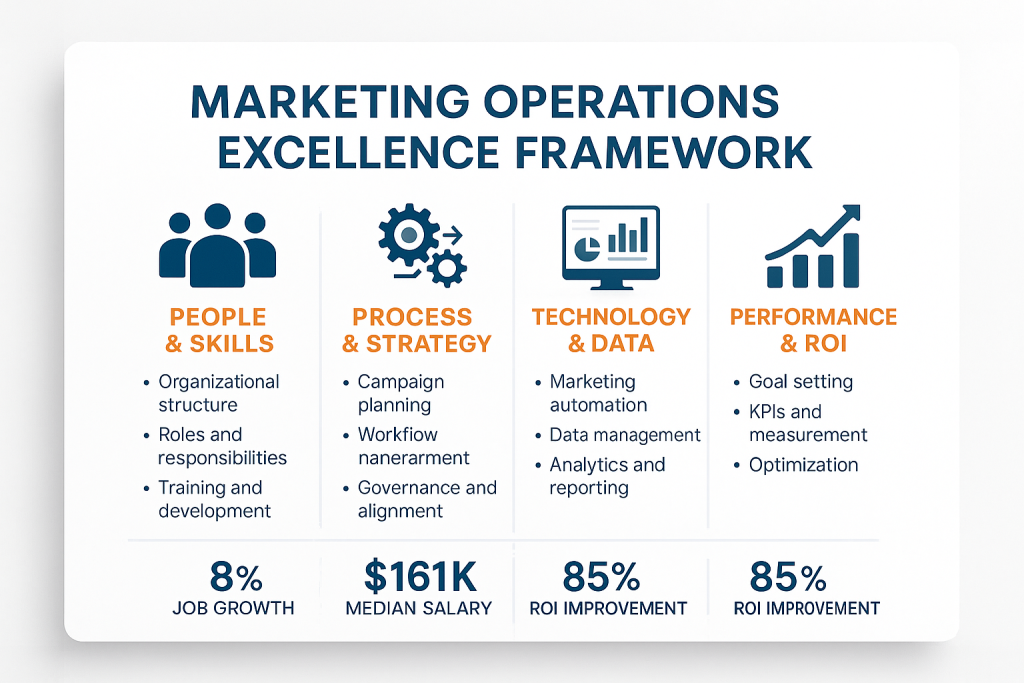
Understanding the Current Marketing Operations Landscape
The contemporary marketing operations environment reflects a complex interplay of technological advancement, evolving customer expectations, and organizational transformation. HubSpot’s 2025 State of Marketing Report reveals that the top marketing channels driving ROI for B2B brands are website, blog, and SEO efforts, followed by paid social media content and social media shopping tools [4]. This data underscores the critical importance of integrated operations that can effectively orchestrate multiple touchpoints while maintaining consistent messaging and measurement.
The financial implications of marketing operations excellence are substantial. Marketing managers earn a median annual wage of $161,030, with advertising and promotions managers earning $126,960, reflecting the high value organizations place on operational expertise [2]. These compensation levels indicate that marketing operations professionals are viewed as strategic assets rather than tactical executors, responsible for driving measurable business outcomes through systematic process improvement and technology optimization.
Yet the path to excellence is fraught with obstacles. Forrester’s research on marketing planning reveals that many organizations treat planning as an anxiety-inducing annual scramble rather than a strategic exercise, often inheriting last year’s approach with minimal strategic consideration [5]. This reactive mindset creates operational inefficiencies that compound over time, limiting an organization’s ability to respond to market changes or capitalize on emerging opportunities.
| Marketing Channel | ROI Effectiveness (%) | Conversion Rate (%) | Key Success Factors |
|---|---|---|---|
| Website/Blog/SEO | 85 | 13.0 | Content quality, technical optimization, user experience |
| Paid Social Media | 78 | 2.8 | Audience targeting, creative optimization, platform selection |
| Email Marketing (B2B) | 68 | 2.4 | Segmentation, personalization, automation workflows |
| Email Marketing (B2C) | 65 | 2.8 | List quality, timing optimization, mobile responsiveness |
| Display Advertising | 45 | 2.0 | Programmatic optimization, retargeting, creative testing |
The Four Pillars of Marketing Operations Excellence
People and Organizational Structure
The foundation of marketing operations excellence rests on having the right people in the right roles with clearly defined responsibilities and decision-making authority. The Bureau of Labor Statistics data reveals that marketing operations professionals typically require a bachelor’s degree plus relevant work experience, reflecting the sophisticated skill set needed to navigate complex organizational dynamics and technological systems [2].
Successful marketing operations teams exhibit several key characteristics. They maintain clear organizational structures that facilitate cross-functional collaboration while avoiding the silos that plague many traditional marketing departments. These teams understand that marketing operations excellence requires more than technical proficiency—it demands strategic thinking, change management capabilities, and the ability to translate business objectives into operational realities.
The human element becomes particularly critical when considering the rapid pace of technological change. As artificial intelligence and automation reshape marketing processes, operations professionals must balance efficiency gains with the need for human insight and creativity. This balance requires continuous learning and adaptation, as evidenced by the growing emphasis on upskilling within marketing operations teams.
Process and Strategic Alignment
Process excellence in marketing operations extends beyond workflow optimization to encompass strategic alignment across the entire organization. Forrester’s research emphasizes the importance of moving from reactive planning to strategic execution, using frameworks like the Marketing Plan on a Page and Strategic Budget Allocation Model to ensure that operational activities directly support business objectives [5].
The most effective marketing operations teams implement what Forrester calls the B2B Process Chain Framework, which includes seven critical categories: strategize, plan, design, build, deploy, measure, and optimize [6]. This framework provides a systematic approach to process management that ensures consistency while maintaining the flexibility needed to respond to changing market conditions.
However, process excellence requires more than framework adoption—it demands cultural transformation. Organizations must shift from viewing processes as constraints to understanding them as enablers of innovation and efficiency. This cultural shift often proves more challenging than technical implementation, requiring sustained leadership commitment and clear communication about the value of operational discipline.
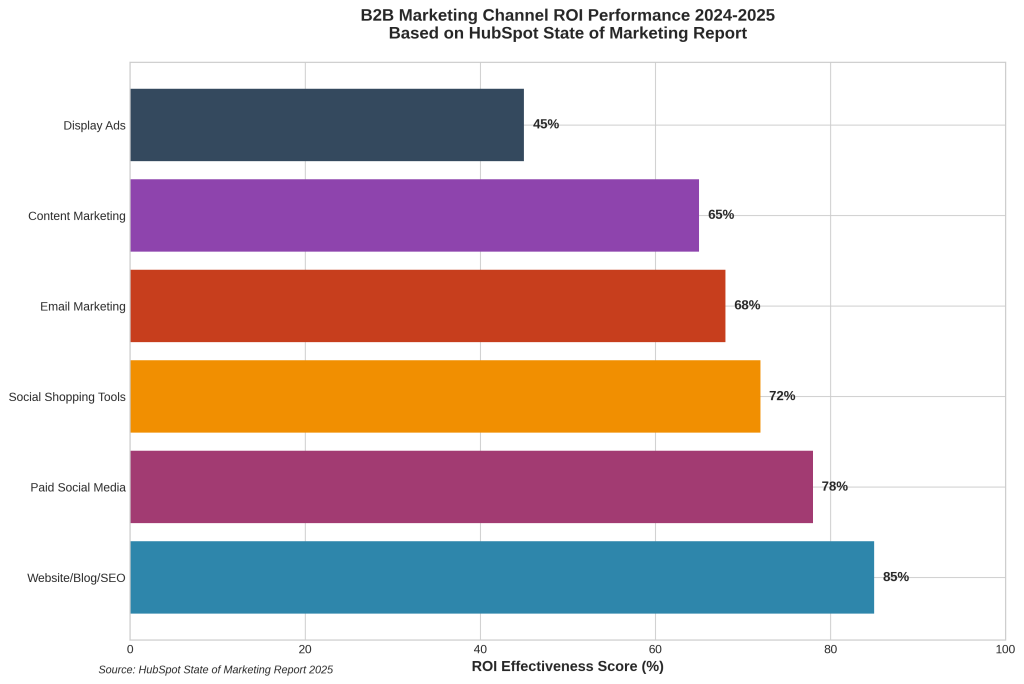
Technology and Data Integration
The technology pillar of marketing operations excellence encompasses both the selection and integration of marketing technology tools and the development of data-driven decision-making capabilities. Industry research indicates that data and analytics tools achieve 89% adoption rates among enterprise organizations, while marketing automation reaches 85% adoption [7]. These high adoption rates reflect the critical importance of technology in achieving operational excellence.
Yet technology adoption alone does not guarantee success. The most effective marketing operations teams focus on integration rather than accumulation, building technology stacks that work seamlessly together rather than creating additional complexity. This integration challenge becomes particularly acute as organizations grapple with the average marketing technology stack, which now includes dozens of individual tools and platforms.
Data integration represents perhaps the most critical aspect of technology excellence. Organizations must move beyond data collection to develop sophisticated analytics capabilities that provide actionable insights. This requires not only technical infrastructure but also analytical skills and the organizational discipline to act on data-driven recommendations even when they challenge conventional wisdom.

Performance Measurement and ROI Optimization
The performance pillar focuses on developing comprehensive measurement frameworks that connect marketing activities to business outcomes. HubSpot research reveals that more than one in three marketing leaders cite conversion rates as their top KPI priority, while nearly two out of three marketers report average landing page conversion rates of less than 10% [4]. These statistics highlight both the importance of performance measurement and the significant room for improvement in most organizations.
Effective performance measurement requires more than tracking traditional marketing metrics—it demands the development of attribution models that accurately reflect the complex customer journey. This complexity has increased significantly as buyers become more autonomous and buying groups more sophisticated, requiring marketing operations teams to develop a nuanced understanding of how different touchpoints contribute to ultimate business outcomes.
ROI optimization extends beyond measurement to encompass continuous improvement processes that systematically identify and address performance gaps. The most successful organizations implement quarterly planning councils that bring together marketing, sales, and product stakeholders to review performance, assess alignment, and make strategic adjustments based on data-driven insights [5].
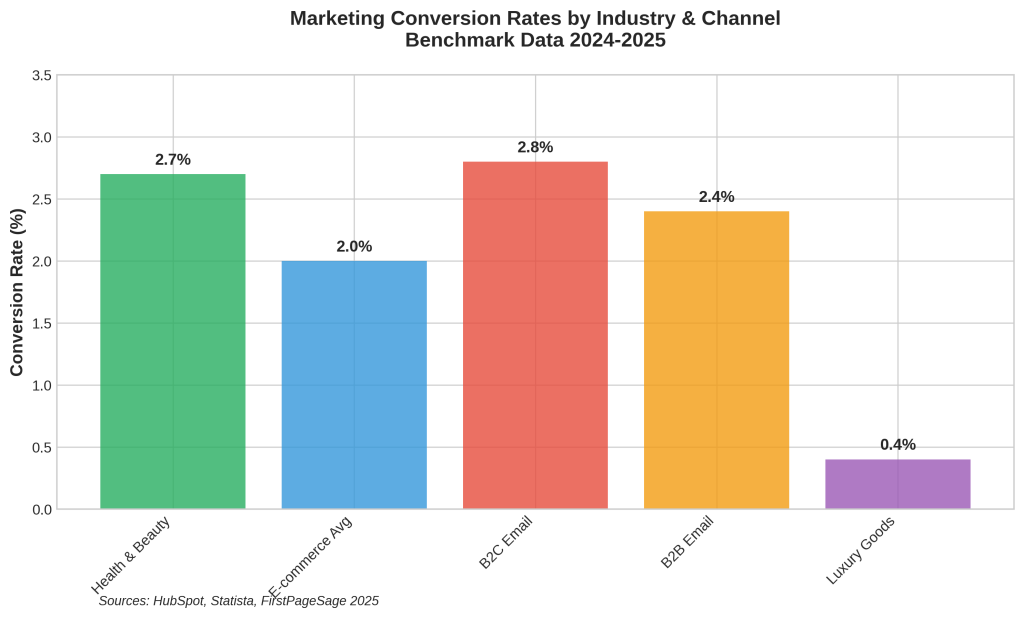
The Marketing Operations Maturity Journey
Understanding marketing operations excellence requires recognizing that organizations progress through distinct maturity stages, each characterized by specific capabilities, challenges, and opportunities. Research from Integrate and McGaw identifies five stages of marketing operations maturity: Initial, Managed, Defined, Quantitatively Managed, and Optimizing [8].
Organizations in the Initial stage typically operate with ad-hoc processes, limited data integration, and reactive approaches to marketing challenges. These organizations often struggle with manual processes, inconsistent reporting, and difficulty demonstrating marketing’s contribution to business outcomes. While this stage presents significant challenges, it also offers substantial opportunities for improvement through systematic process development and technology implementation.
The Managed stage represents the first step toward operational excellence, characterized by basic automation, some standardized metrics, and initial process documentation. Organizations at this stage begin to develop more systematic approaches to marketing operations while still relying heavily on manual intervention and limited cross-functional integration.
Organizations reaching the Defined stage demonstrate standardized processes, integrated systems, and regular reporting capabilities. This stage marks a critical transition point where marketing operations begin to function as a strategic asset rather than a tactical necessity. Cross-functional alignment improves significantly, and organizations develop more sophisticated understanding of customer journey dynamics.
The Quantitatively Managed stage represents advanced operational capability, characterized by sophisticated analytics, predictive insights, and comprehensive ROI measurement. Organizations at this stage leverage data not just for reporting but for strategic decision-making and continuous optimization. They demonstrate the ability to adapt quickly to market changes while maintaining operational consistency.
The Optimizing stage represents marketing operations excellence, characterized by AI-powered optimization, continuous improvement processes, and strategic leadership in organizational transformation. Organizations at this stage serve as models for others, demonstrating how marketing operations can drive competitive advantage through systematic excellence.
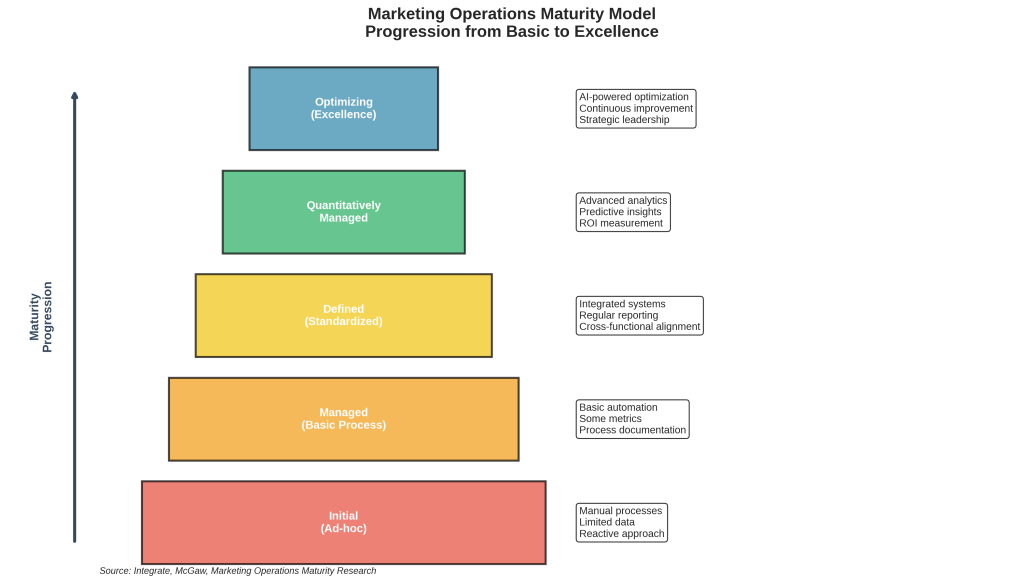
Challenges and Limitations in Achieving Excellence
Despite the clear benefits of marketing operations excellence, organizations face significant challenges in implementation and maintenance. The most common obstacles include data silos, manual processes, lack of integration, ROI measurement gaps, and skills shortages. These challenges often compound each other, creating systemic barriers that require comprehensive solutions rather than tactical fixes.
Data silos represent perhaps the most pervasive challenge, as organizations struggle to integrate information across multiple systems and departments. This fragmentation limits the ability to develop comprehensive customer insights and creates inefficiencies that undermine operational excellence. Addressing data silos requires not only technical solutions but also organizational changes that promote collaboration and information sharing.
Skills shortages present another significant challenge, as the rapid pace of technological change outpaces many organizations’ ability to develop internal capabilities. The specialized nature of marketing operations requires professionals who understand both marketing strategy and technical implementation, a combination that remains relatively rare in the job market. This shortage drives up compensation costs while limiting organizations’ ability to implement sophisticated operational improvements.
Integration challenges extend beyond technology to encompass organizational culture and change management. Many organizations underestimate the cultural transformation required to achieve marketing operations excellence, focusing on technical implementation while neglecting the human factors that ultimately determine success or failure.

Strategic Implementation Framework
Achieving marketing operations excellence requires a systematic approach that addresses people, processes, technology, and performance measurement in an integrated manner. The most successful implementations begin with comprehensive assessment of current capabilities, followed by strategic planning that prioritizes improvements based on business impact and implementation feasibility.
The assessment phase should evaluate organizational readiness across all four pillars of excellence. This includes analyzing current skill sets, process maturity, technology integration, and measurement capabilities. Organizations must honestly assess their starting point to develop realistic timelines and resource requirements for transformation initiatives.
Strategic planning should focus on developing a roadmap that balances quick wins with long-term transformation objectives. The most effective approaches prioritize improvements that demonstrate clear business value while building the foundation for more sophisticated capabilities. This often means starting with process standardization and basic automation before advancing to complex analytics and AI-powered optimization.
Implementation requires careful change management that addresses both technical and cultural factors. Organizations must invest in training and development while also creating incentive structures that reward operational excellence. This dual focus ensures that technical capabilities are matched by organizational commitment to continuous improvement.
| Implementation Phase | Duration | Key Activities | Success Metrics |
|---|---|---|---|
| Assessment & Planning | 2-3 months | Current state analysis, gap identification, roadmap development | Comprehensive assessment report, stakeholder alignment |
| Foundation Building | 6-9 months | Process standardization, basic automation, team training | Process documentation, automation implementation, skill development |
| Integration & Optimization | 9-12 months | System integration, advanced analytics, performance optimization | Integrated reporting, improved ROI, operational efficiency |
| Excellence & Innovation | Ongoing | AI implementation, continuous improvement, strategic leadership | Competitive advantage, innovation leadership, sustained growth |
Future Outlook and Emerging Trends
The future of marketing operations excellence will be shaped by several key trends, including artificial intelligence integration, increased focus on customer experience, and the continued evolution of privacy regulations. Organizations that anticipate and prepare for these trends will be better positioned to maintain competitive advantage in an increasingly complex marketplace.
Artificial intelligence represents perhaps the most significant opportunity for advancing marketing operations excellence. AI-powered tools can automate routine tasks, provide predictive insights, and optimize campaign performance in real-time. However, successful AI implementation requires sophisticated data infrastructure and analytical capabilities that many organizations are still developing.
Customer experience optimization will become increasingly central to marketing operations excellence as organizations recognize that operational efficiency must ultimately serve customer needs. This shift requires marketing operations teams to develop deeper understanding of customer journey dynamics and the ability to optimize processes for customer value rather than internal efficiency alone.
Privacy regulations and data governance requirements will continue to evolve, requiring marketing operations teams to balance personalization objectives with compliance requirements. Organizations that develop robust data governance frameworks will be better positioned to navigate this complex landscape while maintaining operational effectiveness.
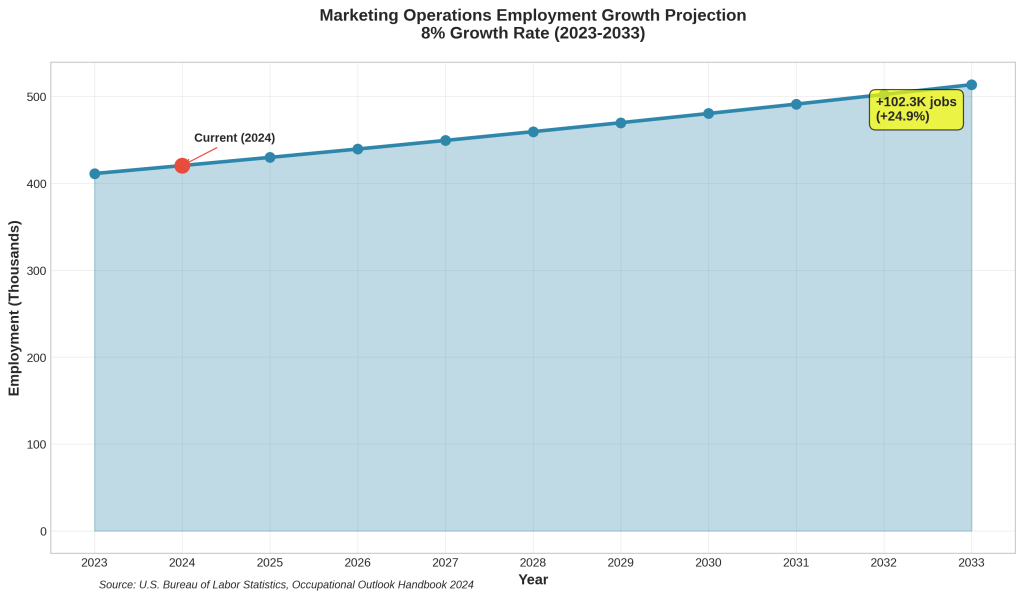
Key Takeaways for Marketing Operations Excellence
Marketing operations excellence represents a strategic imperative for organizations seeking competitive advantage in today’s complex business environment. The evidence from government data, industry research, and academic studies demonstrates that systematic investment in operational excellence delivers measurable business results while positioning organizations for future growth.
The four pillars of excellence—people, processes, technology, and performance—must be addressed in an integrated manner rather than as isolated initiatives. Organizations that achieve excellence demonstrate sophisticated understanding of how these elements interact and reinforce each other to create sustainable competitive advantage.
The maturity journey requires patience and sustained commitment, as transformation typically occurs over multiple years rather than months. Organizations must balance the need for quick wins with long-term capability development, ensuring that tactical improvements support strategic objectives rather than creating additional complexity.
Success requires addressing both technical and cultural factors, as operational excellence ultimately depends on people’s willingness to embrace new ways of working. Organizations must invest in change management and training while also creating incentive structures that reward operational discipline and continuous improvement.
The future belongs to organizations that can effectively integrate human insight with technological capability, creating marketing operations that are both efficient and innovative. This integration requires sophisticated understanding of customer needs, market dynamics, and organizational capabilities—a combination that represents the essence of marketing operations excellence.
References
[1] Forrester Research. (2025). Marketing Operations Effectiveness. Forrester Blog.
[2] U.S. Bureau of Labor Statistics. (2024). Advertising, Promotions, and Marketing Managers. Occupational Outlook Handbook.
[3] Library of Congress. (2025). Marketing Industry Data – A Resource Guide. Research Guides.
[4] HubSpot. (2025). 2025 Marketing Statistics, Trends & Data. State of Marketing Report.
[5] Moore, C. (2025). Turn Marketing Planning From A Source Of Anxiety To A Source Of Clarity. Forrester Blog.
[6] Brown, V. (2025). Sync Or Swim: Mastering B2B Processes. Forrester Blog.
[7] Statista. (2024). Marketing Technology Stack Adoption Rates. Business Intelligence Portal.
[8] Integrate. (2024). The 5 Stages of Marketing Operations Maturity. Marketing Operations Research.

